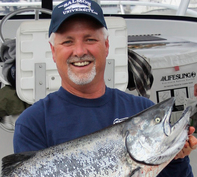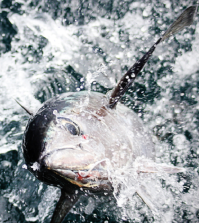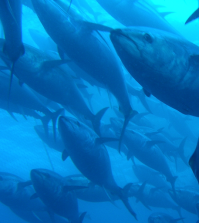Tuna Fishing Washington (Part 1)
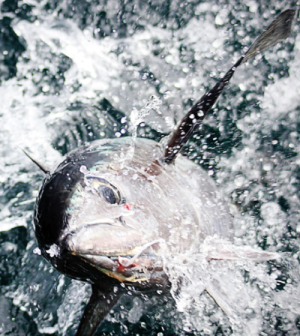
Every year around the beginning of July, the warm currents off the California coast make their way north through Oregon and into the waters off the state of Washington.
Along with that comes one of the tastiest fish that swim in the ocean: the Albacore Tuna. The excitement felt by fishermen along the coast has been compared to a giant rush of adrenalin. Each year more and more fishermen are joining in on this fishery, buying gear, and rigging their boats to chase after one of the most sustainable fish in the Pacific Ocean.
We here at Salmon University wanted to take some time to help you out with some tips and pointers as you prepare to go tuna fishing. This certainly will not cover everything but it might help answer some of your questions. In this segment I will cover basic items like preparing your boat and planning your trip, then in the next I will cover, gear and equipment needed for the different styles of tuna fishing, and lastly I will cover what to do when you reach the tuna grounds.
Preparing the Boat
First off, you need the right boat. Not every boat is made for every fishery and it is especially true when it comes to Tuna fishing. Most trips out of Westport are between 35 and 55 miles from the jetties. There are many things to consider. First do you have the right boat? I recommend a boat at least 23 feet in length. Two engines is a must. There is always a lot of debate each year regarding whether or not a “kicker motor” is enough for a second engine. Twin large motors would be preferred but a small second outboard is better than just having a single engine. Always remember that if you are 40 miles from the port how long will it take you to return home on a “Kicker?” The United States Coast Guard will not come and tow you home unless you are in danger. They will assist in helping you in arranging a tow if someone is available but, counting on a Good Samaritan to help is not the way to go. You need a boat with covered protection. It can get pretty nasty on some days so you want to have a dry place for the ride out and back. Fuel capacity is a big consideration too. Always remember the rule of thirds. You should always plan your trips to return to the docks with 1/3 of your capacity still in your tank. This means, if your boat carries 150 gallons of fuel you should plan your day to use no more the 100 gallons of that fuel. This provides you enough fuel in reserve to be able to deal with most any situation that may arise.
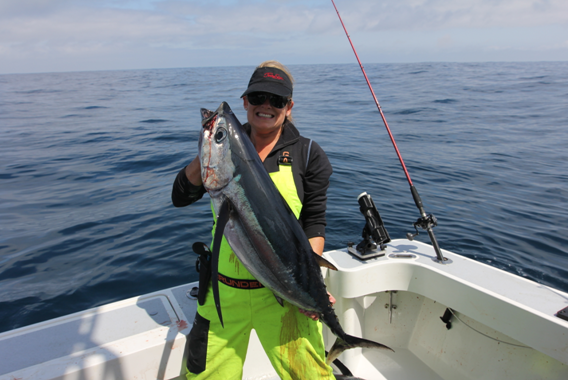 Next is the carrying capacity of your boat. By the time you fuel up, figure approximately seven pounds per gallon, load people, gear, and ice it adds up fast. Make sure you do not overload your boat. As far as ice goes, you need to plan on three to five pounds of ice per fish. Tuna are very warm, even hot, inside when they are landed and must be cooled down quickly. Open the belly of one sometime and place your hand inside. You will see what I mean. Ice can be purchased by the bag at any store but the best option is flaked ice which you can buy in bulk. I get my ice from Westport Seafood here in Westport. They are located at the end of the marina on the spit. You must purchase a full tote of ice, which is about 800 pounds. If you have your own Tote they will fill it or they have totes that they will fill and you can transfer it into you own coolers or Kill Bags. The cost is approximately $50 per tote. Now you have the ice, what do you do with it? Most guys will load the fish boxes with it, place a few large coolers on the boat, or use a soft side insulated bag. These are large insulated storage bags, which will hold plenty of ice and tuna. I use Reliable Kill Bags.
Next is the carrying capacity of your boat. By the time you fuel up, figure approximately seven pounds per gallon, load people, gear, and ice it adds up fast. Make sure you do not overload your boat. As far as ice goes, you need to plan on three to five pounds of ice per fish. Tuna are very warm, even hot, inside when they are landed and must be cooled down quickly. Open the belly of one sometime and place your hand inside. You will see what I mean. Ice can be purchased by the bag at any store but the best option is flaked ice which you can buy in bulk. I get my ice from Westport Seafood here in Westport. They are located at the end of the marina on the spit. You must purchase a full tote of ice, which is about 800 pounds. If you have your own Tote they will fill it or they have totes that they will fill and you can transfer it into you own coolers or Kill Bags. The cost is approximately $50 per tote. Now you have the ice, what do you do with it? Most guys will load the fish boxes with it, place a few large coolers on the boat, or use a soft side insulated bag. These are large insulated storage bags, which will hold plenty of ice and tuna. I use Reliable Kill Bags.
You have your ice and your fuel – what next? You must make sure you have a good method to communicate. A VHF radio is a basic means of communication that works fine if you are around other boats. Its range is only line of sight so you may not be able to reach help if needed. I recommend that you go at least one step further. Purchase a PLB (personal locator beacon) or EPIRB (Emergency Position Indicating Radio Beacon). These will give you the ability to send out a distress signal quickly if you need help. They range in price from $100 to $500 and must be registered with the U.S. Coast Guard. These items may not seem necessary but they are well worth the peace of mind they give you.
Make sure your safety gear is all up to date. Have a first aid kit on board that is more than band aids and aspirin. You really need to be prepared. You need to have plenty of water on board – figure one-gallon person. Make sure you have some food with you also, something more than chips and beer. You need to ask yourself what if we have an issue and it takes a day or so to get help? Be prepared.
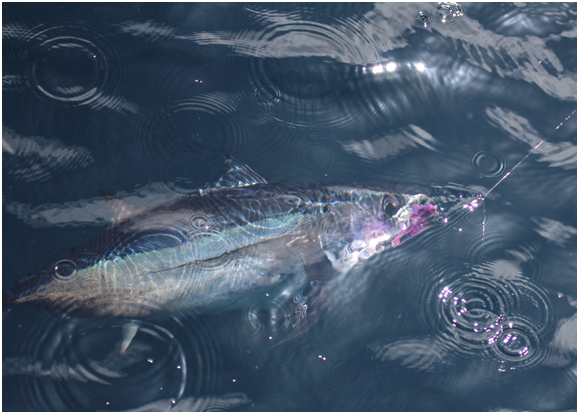 Now we have our boat fully fueled, our safety gear, water, food what is next? Plan your trip! There are a few websites available to help you in your search. The two main things we look for are the warm water breaks and the clear water. Albacore tuna like water temperatures from 59 degrees to 70 degrees and they like clear water. Rip Charts and Terrafin SST are subscription websites that you can look at to find the right water. Ideally you want to find the edge between the cooler water and the continuous mass of warm water not just a patch of warm water.
Now we have our boat fully fueled, our safety gear, water, food what is next? Plan your trip! There are a few websites available to help you in your search. The two main things we look for are the warm water breaks and the clear water. Albacore tuna like water temperatures from 59 degrees to 70 degrees and they like clear water. Rip Charts and Terrafin SST are subscription websites that you can look at to find the right water. Ideally you want to find the edge between the cooler water and the continuous mass of warm water not just a patch of warm water.
Find that area, write down the latitude and longitude numbers and make that your starting point for the next day. This area could be anywhere from 45 miles straight out from Westport to 55 miles southwest of Westport straight out from Ilwaco. It will vary. The key here is Plan! Plan! Plan! If it is too far, stay home and plan for another day.
Lastly and without question is the Weather! You have a very heavy boat now which will change its performance characteristics so you really have to look at this closely. Do not look at the surf forecast or just the forecast out to 10 nautical miles. You need to look at the off shore forecast, out to 60 Nautical miles. It can be really calm in close but be very ugly far out. Watch the winds. Here is a quick rule of thumb I use. If the Height of the Swell plus the Height of the wind waves is equal to or greater the seconds between the swells then it is a NO GO! Safety is always the first consideration. Now we are ready to go.
continue to part two of this series


